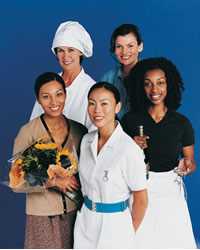Women's Safety and Health Issues at Work

Health Concerns: Bloodborne Diseases
Exposures to blood or other infectious materials in the workplace can put employees at risk of getting a bloodborne disease, such as hepatitis B, hepatitis C and human immunodeficiency virus (HIV). Working in health care, medical labs or housekeeping may increase the chance of contact with blood or other body fluids.
NIOSH Publications
How to Prevent Needlestick and Sharps Injuries
DHHS (NIOSH) Publication No. 2012-123 (February 2012)
Preventing Needlestick Injuries in Health Care Settings
DHHS (NIOSH) Publication No. 2000-108 (November 1999)
Related Resources
A safety information campaign to reduce sharps injuries: results from the Stop Sticks campaign
A communication intervention designed to raise awareness among healthcare workers about the risks of sharps injuries and bloodborne pathogens exposure as well as methods of prevention was evaluated. Findings revealed high levels of knowledge and communication channel recall, minimal attitude and behavior change, and a strong association between sharps-related safety behavior and safety climate. Overall, findings suggest that the blitz approach is viable for raising awareness of occupational safety and health issues.
Characteristics of persons and jobs with needlestick injuries in a national data set
When occupational data was examined for needlesticks, women made up 73% of the people injured. Occupations with greatest frequencies included registered nurses, nursing aides and orderlies, janitors and cleaners, licensed practical nurses, and maids and housemen. Occupations with greatest risks included biologic technicians, janitors and cleaners, and maids and housemen.
Evaluation of home health care nurses’ practice and their employers’ policies related to bloodborne pathogens
A study involving home health care nurses and employers found that more home health care nurses than employers reported needlestick injuries. An index was developed to evaluate employer compliance with OSHA's Bloodborne Pathogens Standard. Its use can help employers review and revise their exposure control plans to ensure compliance.
Occupational risk factors for blood and body fluid exposure among home care aides
This study of home care aides highlighted the importance of, and need for, home care aide training in using universal precautions due to blood and body fluid exposures.
Potential work-related bloodborne pathogen exposures by industry and occupation in the United States Part I: An emergency department-based surveillance study
This study looked at the extent of possible work- related bloodborne pathogen exposures in the United States across all industries and occupations. National estimates of exposures and exposure rates were computed from the 1998 to 2000 National Electronic Injury Surveillance System.
Prevalence and risk factors for bloodborne exposure and infection in correctional healthcare workers
NIOSH researchers examined how well the guidance for reducing exposures to bloodborne pathogens was being followed in correctional healthcare. Room for improvement was noted in involving front-line workers in evaluating and selecting safer medical devices and in updating and maintaining required exposure control plans.
Provision and use of personal protective equipment among home care and hospice nurses in North Carolina
The study found that the public health policy of providing personal protective equipment (PPE) to health care workers and ensuring that they use that equipment to prevent occupational blood exposure is not being fully implemented for home care and hospice nurses. Greater provision of PPE could reduce blood exposure in this population. Conditions of the home care/hospice work environment may be impeding nurses’ ability to use PPE.
Sharps injuries and other blood and body fluid exposures among home health care nurses and aides
Results of surveys and workplace-based surveillance revealed that sharps and other blood and body fluid exposures are serious hazards for home health care nurses and aides.
There's no place like home: a qualitative study of the working conditions of home health care providers
This study described the work experience and hazards of home health care providers, with a focus on risk factors for bloodborne pathogen exposures. The study found home health care providers face serious work-related hazards, including violence in neighborhoods and homes, lack of workstations, heavy patient lifting, improper disposal of dressings or sharp medical devices, and high productivity demands.
Work schedule, needle use, and needlestick injuries among registered nurses
Longer hours per day, weekend work, and working while sick were found to be related to increased number of needlestick injuries in RNs.
- Page last reviewed: April 23, 2013
- Page last updated: August 27, 2013
- Content source:
- National Institute for Occupational Safety and Health
Office of the Director
- National Institute for Occupational Safety and Health


 ShareCompartir
ShareCompartir